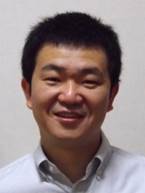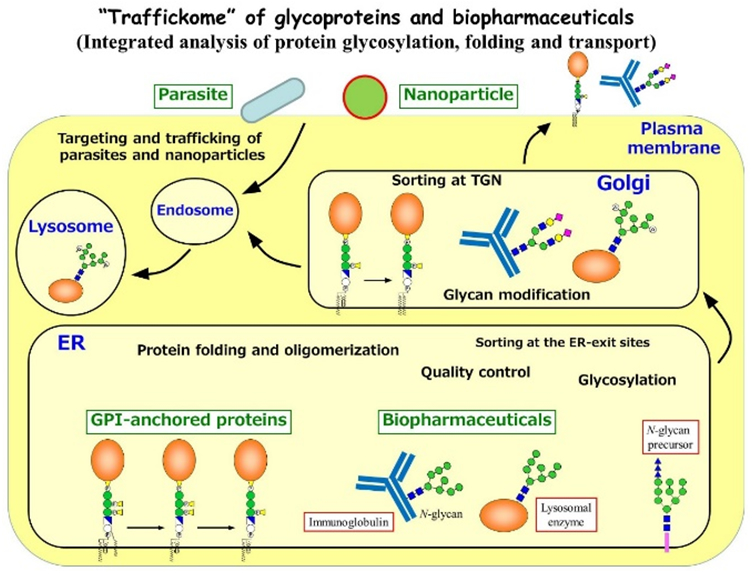
组长简介
姓名: 藤田盛久(Morihisa Fujita)
出生年月: 1979年5月4日
职称: 教授,博士生导师
研究领域: 生化学,糖生物学,体細胞遺伝学
E-mail: fujita@jiangnan.edu.cn
教育背景:
2004-2006 日本 筑波大学 生命環境科学研究科 获博士学位
2002-2004 日本 筑波大学 生命環境科学研究科 获硕士学位
1998-2002 日本 筑波大学 第二学群 生物資源学類 获学士学位
工作经历:
2014-现在 江南大学 生物工程学院 教授
2012-2014 日本 大阪大学 微生物病研究所 助理教授
2008-2012 日本 大阪大学 微生物病研究所 特任助理教授
2007-2008 日本 大阪大学 微生物病研究所 博士后
2006-2007 瑞士日内瓦大学 生物化学学院博士后
2006-2006 日本 产业技术综合研究所糖锁研究中心博士后
研究队伍:
姓名: 喜多島敏彦(Kitajima Toshihiko)
职称: 副教授
研究領域: 生物化学、糖生物学
E-mail: kitajima@jiangnan.edu.cn
主要研究内容、目标及进展
Our research interests are in the field of protein glycosylation and trafficking in eukaryotic cells. We are particularly focusing on understanding the physiological functions of a post-translational modification by a glycolipid termed glycosylphosphatidylinositol (GPI). So far, we identified and characterized genes required for structural remodeling of GPI-anchors. These works contribute to not only basic research but also medical research. Currently, we tries to understand the processes of intracellular trafficking of biologically and therapeutically important glycoproteins. To reveal the processes, we performs integrated analyses including genetic, cell biological and biochemical approaches using mammalian and yeast cells. The following subjects are main projects in our group.
1. Regulatory Mechanisms of Intracellular Transport of Glycoproteins
We are interested in the research regarding “Life of Glycoproteins”, which includes protein glycosylation, folding, sorting and transport. Most of secretory proteins are synthesized and glycosylated in the endoplasmic reticulum (ER). After the glycoproteins are folded and oligomerized, they are transported from the ER to the Golgi and are further delivered to the final destination. Using genetic and biochemical approaches, we try to identify and characterize factors required for glycoprotein transport and recombinant biopharmaceutical production.
2. Engineering of Mammalian Cells to Produce Biopharmaceuticals
Recombinant therapeutic proteins are becoming very important pharmaceutical agents for treating intractable diseases such as cancer and autoimmune diseases. Currently, complex therapeutic proteins are produced in mammalian cells, since most of them are difficult to form correct folding in other alternative organisms, and requires proper glycosylation for their stability and functions. However, production of biopharmaceuticals in mammalian cells still has some issues such as cost, low production, and heterogeneity of glycans. To overcome the issues, we engineer mammalian host cells and optimize them to produce biopharmaceuticals.

研究成果
Selected Papers
1. Matabaro, E., He, Z., Liu, Y.S., Zhang, H.J., Gao, X.D., Fujita, M.*: Molecular switching system using glycosylphosphatidylinositol to select cells highly expressing recombinant proteins. Sci. Rep., in press (2017)
2. Lee, G.H.#, Fujita, M.#, Takaoka, K., Murakami, Y., Fujihara, Y., Kanzawa, N., Murakami, K.I., Kajikawa, E., Takada, Y., Saito, K., Ikawa, M., Hamada, H., Maeda, Y., Kinoshita, T. (#equally contributed): A GPI processing phospholipase A2, PGAP6, modulates Nodal signaling in embryos by shedding CRIPTO. J. Cell Biol., 215(5): 705-718 (2016)
3. Rong, Y., Nakamura, S., Hirata, T., Motooka, D., Liu, Y.S., He, Z., Gao, X.D., Maeda, Y., Kinoshita, T., Fujita, M.*: Genome-Wide Screening of Genes Required for Glycosylphosphatidylinositol Biosynthesis. PLoS One, 10(9): e0138553 (2015)
4. Hirata, T.#, Fujita, M.#,*, Nakamura, S., Gotoh, K., Motooka, D., Murakami, Y., Maeda, Y., and Kinoshita, T.* (#equally contributed,*corresponding author): Post-Golgi anterograde transport requires GARP-dependent endosome to TGN retrograde transport. Mol. Biol. Cell, in press (2015)
5. Theiler, R., Fujita, M., Nagae, M., Yamaguchi, Y., Maeda, Y., Kinoshita, T.: The α-helical region in p24γ2 subunit of p24 protein cargo receptor is pivotal for the recognition and transport of glycosylphosphatidylinositol-anchored proteins. J Biol Chem., 289(24): 16835-43 (2014)
6. Fujita, M., Watanabe, R., Jaensch, N., Romanova-Michaelides, M., Satoh, T., Kato, M., Riezman, H., Yamaguchi, Y., Maeda, Y., and Kinoshita, T.: Sorting of GPI-anchored proteins into ER exit sites by p24 proteins is dependent on remodeled GPI., J. Cell Biol., 194: 61-75 (2011)
7. Fujita, M., Maeda, Y., Ra, M., Yamaguchi, Y., Taguchi, R., and Kinoshita, T.: GPI glycan remodeling by PGAP5 regulates transport of GPI-anchored proteins from the endoplasmic reticulum to the Golgi., Cell, 139: 352-365 (2009)
8. Fujita, M., Umemura, M., Yoko-o, T., and Jigami, Y.: PER1 is required for GPI-phospholipase A2 activity and involved in lipid remodeling of GPI-anchored proteins., Mol. Biol. Cell, 17(12): 5253-64 (2006)
9. Fujita, M.*and Kinoshita, T.*(*corresponding author): GPI-anchor remodeling: Potential functions of GPI-anchors in intracellular trafficking and membrane dynamics., Biochim. Biophys. Acta, 1821 (8): 1050-1058 (2012)
10. Fujita, M. and Kinoshita, T.: Structural remodeling of GPI anchors during biosynthesis and after attachment to proteins., FEBS Lett., 584 (9): 1670-1677 (2010)
主要科研项目
2014年江苏省自然科学基金青年基金
2014年国家自然科学基金
荣誉&奖励
2014年江苏省特聘教授 2015年江苏省高层次创新创业人才计划

